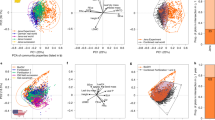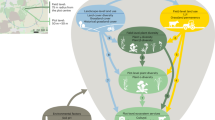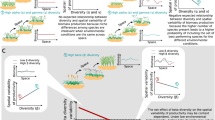Abstract
Biodiversity is declining in many local communities while also becoming increasingly homogenized across space. Experiments show that local plant species loss reduces ecosystem functioning and services, but the role of spatial homogenization of community composition and the potential interaction between diversity at different scales in maintaining ecosystem functioning remains unclear, especially when many functions are considered (ecosystem multifunctionality). We present an analysis of eight ecosystem functions measured in 65 grasslands worldwide. We find that more diverse grasslands—those with both species-rich local communities (α-diversity) and large compositional differences among localities (β-diversity)—had higher levels of multifunctionality. Moreover, α- and β-diversity synergistically affected multifunctionality, with higher levels of diversity at one scale amplifying the contribution to ecological functions at the other scale. The identity of species influencing ecosystem functioning differed among functions and across local communities, explaining why more diverse grasslands maintained greater functionality when more functions and localities were considered. These results were robust to variation in environmental drivers. Our findings reveal that plant diversity, at both local and landscape scales, contributes to the maintenance of multiple ecosystem services provided by grasslands. Preserving ecosystem functioning therefore requires conservation of biodiversity both within and among ecological communities.
This is a preview of subscription content, access via your institution
Access options
Access Nature and 54 other Nature Portfolio journals
Get Nature+, our best-value online-access subscription
$29.99 / 30 days
cancel any time
Subscribe to this journal
Receive 12 digital issues and online access to articles
$119.00 per year
only $9.92 per issue
Buy this article
- Purchase on Springer Link
- Instant access to full article PDF
Prices may be subject to local taxes which are calculated during checkout



Similar content being viewed by others
References
Cardinale, B. J. et al. Biodiversity loss and its impact on humanity. Nature 486, 59–67 (2012).
Naeem, S., Bunker, D. E., Hector, A., Loreau, M. & Perrings, C. Biodiversity, Ecosystem Functioning, & Human Wellbeing: An Ecological and Economic Perspective Vol. 44 (Oxford Univ. Press, Oxford, 2010).
Hooper, D. U. et al. Effects of biodiversity on ecosystem functioning: a consensus of current knowledge. Ecol. Monogr. 75, 3–35 (2005).
Loreau, M. et al. Ecology-biodiversity and ecosystem functioning: current knowledge and future challenges. Science 294, 804–808 (2001).
Tilman, D., Isbell, F. & Cowles, J. M. Biodiversity and ecosystem functioning. Annu. Rev. Ecol. Evol. Syst. 45, 471–493 (2014).
Hautier, Y. et al. Anthropogenic environmental changes affect ecosystem stability via biodiversity. Science 348, 336–340 (2015).
van der Plas, F. et al. Biotic homogenization can decrease landscape-scale forest multifunctionality. Proc. Natl Acad. Sci. USA 113, 3557–3562 (2016).
Pasari, J. R., Levia, T., Zavaletaa, E. S. & Tilman, D. Several scales of biodiversity affect ecosystem multifunctionality. Proc. Natl Acad. Sci. USA 110, 10219–10222 (2013).
Newbold, T. et al. Global effects of land use on local terrestrial biodiversity. Nature 520, 45–50 (2015).
Murphy, G. E. P. & Romanuk, T. N. A meta-analysis of declines in local species richness from human disturbances. Ecol. Evol. 4, 91–103 (2014).
McKinney, M. L. & Lockwood, J. L. Biotic homogenization: a few winners replacing many losers in the next mass extinction. Trends Ecol. Evol. 14, 450–453 (1999).
Vellend, M. et al. Global meta-analysis reveals no net change in local-scale plant biodiversity over time. Proc. Natl Acad. Sci. USA 110, 19456–19459 (2013).
Dornelas, M. et al. Assemblage time series reveal biodiversity change but not systematic loss. Science 344, 296–299 (2014).
Ferrier, S. et al. Mapping more of terrestrial biodiversity for global conservation assessment. Bioscience 54, 1101–1109 (2004).
Isbell, F. et al. Linking the influence and dependence of people on biodiversity across scales. Nature 546, 65–72 (2017).
Isbell, F. et al. High plant diversity is needed to maintain ecosystem services. Nature 477, 199–202 (2011).
Hector, A. & Bagchi, R. Biodiversity and ecosystem multifunctionality. Nature 448, 188–190 (2007).
Tscharntke, T., Klein, A. M., Kruess, A., Steffan-Dewenter, I. & Thies, C. Landscape perspectives on agricultural intensification and biodiversity — ecosystem service management. Ecol. Lett. 8, 857–874 (2005).
Borer, E. T. et al. Finding generality in ecology: a model for globally distributed experiments. Methods Ecol. Evol. 5, 63–73 (2013).
Mori, A. S. et al. Low multifunctional redundancy of soil fungal diversity at multiple scales. Ecol. Lett. 19, 249–259 (2016).
Byrnes, J. E. K. et al. Investigating the relationship between biodiversity and ecosystem multifunctionality: challenges and solutions. Methods Ecol. Evol. 5, 111–124 (2014).
Maestre, F. T. et al. Plant species richness and ecosystem multifunctionality in global drylands. Science 335, 214–218 (2012).
Zavaleta, E. S., Pasari, J. R., Hulvey, K. B. & Tilman, G. D. Sustaining multiple ecosystem functions in grassland communities requires higher biodiversity. Proc. Natl Acad. Sci. USA 107, 1443–1446 (2010).
Gotelli, N. J., Ulrich, W. & Maestre, F. T. Randomization tests for quantifying species importance to ecosystem function. Methods Ecol. Evol. 2, 634–642 (2011).
Calcagno, V. & de Mazancourt, C. glmulti: an R package for easy automated model selection with (generalized) linear models. J. Stat. Softw. 34, 1–29 (2010).
Wagg, C., Bender, S. F., Widmer, F. & van der Heijden, M. G. A. Soil biodiversity and soil community composition determine ecosystem multifunctionality. Proc. Natl Acad. Sci. USA 111, 5266–5270 (2014).
Delgado-Baquerizo, M. et al. Microbial diversity drives multifunctionality in terrestrial ecosystems. Nat. Commun. 7, 10541 (2016).
Jing, X. et al. The links between ecosystem multifunctionality and above- and belowground biodiversity are mediated by climate. Nat. Commun. 6, 9159 (2015).
Olson, J. Energy storage and the balance of producers and decomposers in ecological systems. Ecology 44, 322–331 (1963).
O’Halloran, L. R. et al. Regional contingencies in the relationship between aboveground biomass and litter in the world’s grasslands. PLoS ONE 8, e54988 (2013).
Gamfeldt, L., Hillebrand, H. & Jonsson, P. R. Multiple functions increase the importance of biodiversity for overall ecosystem functioning. Ecology 89, 1223–1231 (2008).
Peter, H. et al. Multifunctionality and diversity in bacterial biofilms. PLoS ONE 6, e23225 (2011).
Hijmans, R. J., Cameron, S. E., Parra, J. L., Jones, P. G. & Jarvis, A. Very high resolution interpolated climate surfaces for global land areas. Int. J. Climatol. 25, 1965–1978 (2005).
Hautier, Y. et al. Eutrophication weakens stabilizing effects of diversity in natural grasslands. Nature 508, 521–525 (2014).
He, J. Z., Ge, Y., Xu, Z. H. & Chen, C. R. Linking soil bacterial diversity to ecosystem multifunctionality using backward-elimination boosted trees analysis. J. Soils Sediments 9, 547–554 (2009).
McCullagh, P. & Nelder, J. A. Generalized Linear Models 2nd edn (Chapman & Hall/CRC, Boca Raton, 1989).
Venables, W. N. & Ripley, B. D. Modern Applied Statistics with S (Springer, New York, 2002).
Johnson, J. B. & Omland, K. S. Model selection in ecology and evolution. Trends Ecol. Evol. 19, 101–108 (2004).
R Development Core Team R: A Language and Environment for Statistical Computing (R Foundation for Statistical Computing, Vienna, 2012).
Acknowledgements
The research leading to these results has received funding from the European Union Seventh Framework Programme (FP7/2007-2013) under grant agreement no. 298935 to Y.H. (with A.H. and E.W.S.). This work was generated using data from the Nutrient Network (http://www.nutnet.org) experiment, funded at the site scale by individual researchers. Coordination and data management have been supported by funding from the National Science Foundation Research Coordination Network (NSF-DEB-1042132) to E.T.B. and E.W.S, and from the Long Term Ecological Research (LTER) programme (NSF-DEB-1234162), and the Institute on the Environment at the University of Minnesota (DG-0001-13). We also thank the Minnesota Supercomputer Institute for hosting project data, and the Institute on the Environment for hosting Network meetings. We thank R. S. L. Veiga for suggestions that improved the manuscript.
Author information
Authors and Affiliations
Contributions
Y.H., F.I. and A.H. developed and framed research questions. Y.H., F.I. and A.H. analysed the data and wrote the paper with contributions and input from all authors. E.T.B., E.W.S., K.L.P. and J.D.B. contributed to data analysis. E.W.S., E.T.B., W.S.H. and E.M.L. are Nutrient Network coordinators. All authors collected data used in this analysis. The author contribution matrix is provided as Supplementary Table 6.
Corresponding author
Ethics declarations
Competing interests
The authors declare no competing financial interests.
Additional information
Publisher’s note: Springer Nature remains neutral with regard to jurisdictional claims in published maps and institutional affiliations.
Electronic supplementary material
Supplementary Information
Supplementary Figures 1–8, Supplementary Tables 1–6
Rights and permissions
About this article
Cite this article
Hautier, Y., Isbell, F., Borer, E.T. et al. Local loss and spatial homogenization of plant diversity reduce ecosystem multifunctionality. Nat Ecol Evol 2, 50–56 (2018). https://doi.org/10.1038/s41559-017-0395-0
Received:
Accepted:
Published:
Issue Date:
DOI: https://doi.org/10.1038/s41559-017-0395-0
This article is cited by
-
Plant diversity increases spatial stability of aboveground productivity in alpine grasslands
Oecologia (2024)
-
Key questions for understanding drivers of biodiversity-ecosystem service relationships across spatial scales
Landscape Ecology (2024)
-
Strategies and Barriers to Reconcile Pest Management with Insect Conservation in Temperate and Boreal Forests
Current Forestry Reports (2024)
-
Experimental impacts of grazing on grassland biodiversity and function are explained by aridity
Nature Communications (2023)
-
The 30-year impact of post-windthrow management on the forest regeneration process in northern Japan
Landscape and Ecological Engineering (2023)



